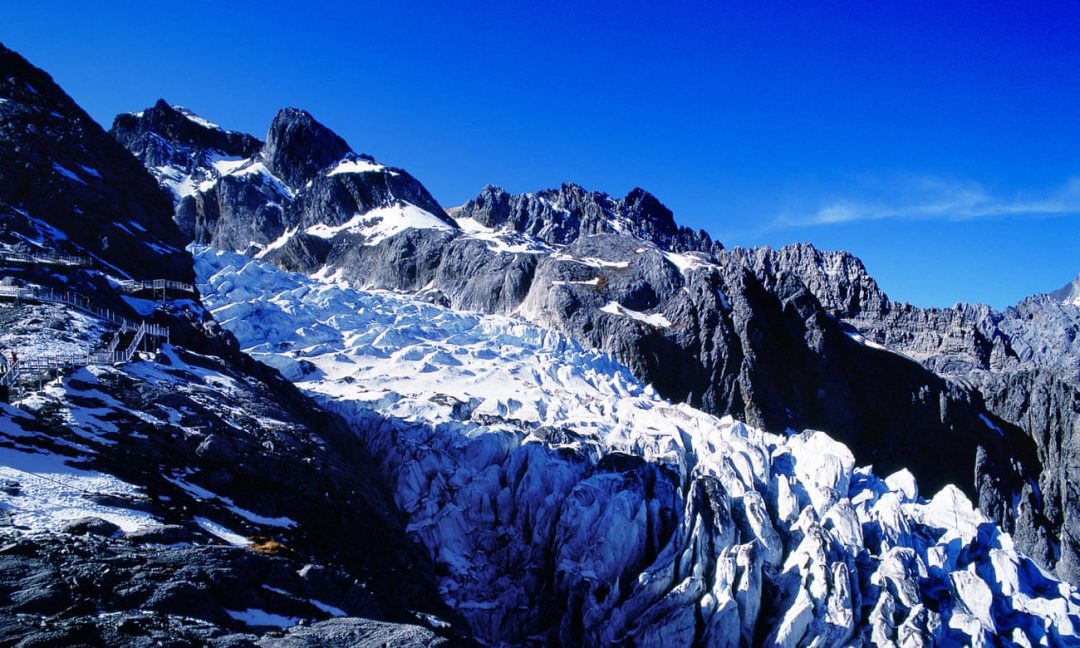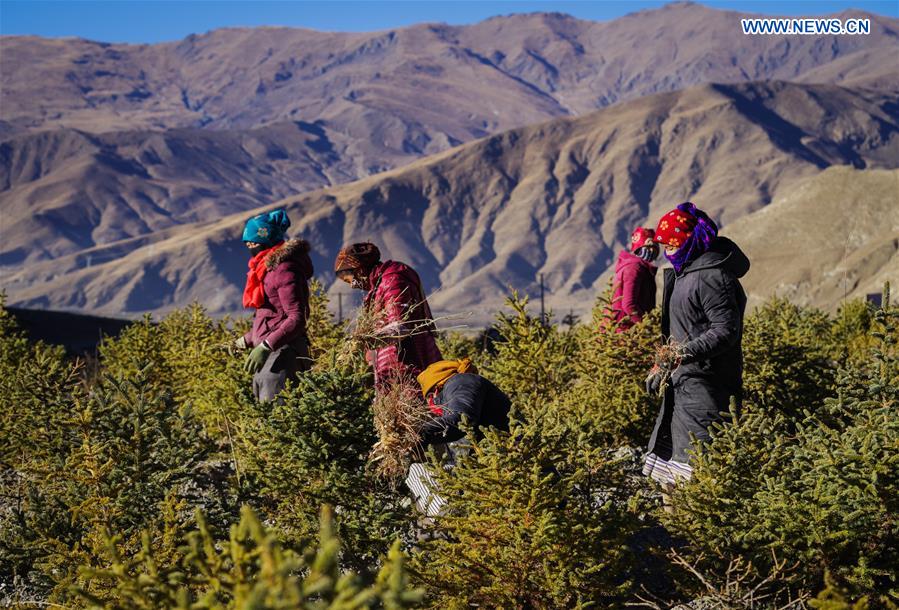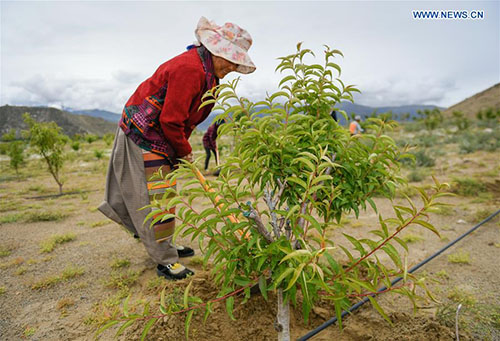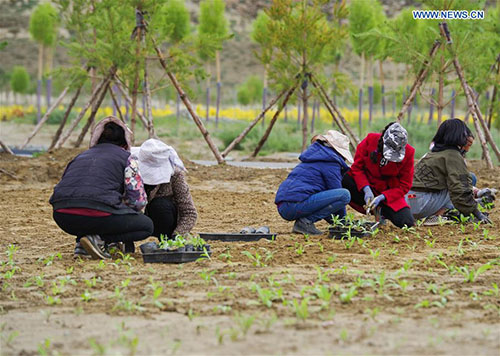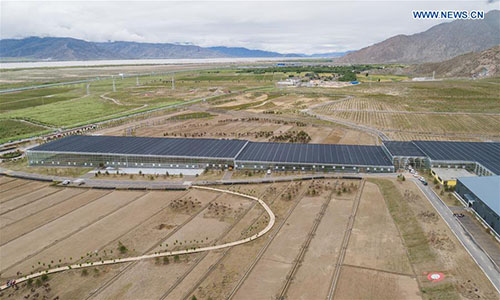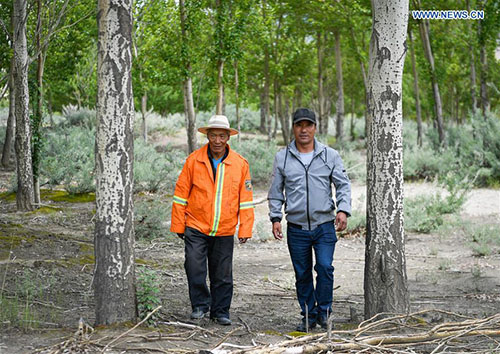Many moons ago in Tibet, the Second Buddha transformed a fierce nyen (a malevolent mountain demon) into a neri (the holiest protective warrior god) called Khawa Karpo, who took up residence in the sacred mountain bearing his name. Khawa Karpo is the tallest of the Meili mountain range, piercing the sky at 6,740 metres (22,112ft) above sea level. Local Tibetan communities believe that conquering Khawa Karpo is an act of sacrilege and would cause the deity to abandon his mountain home. Nevertheless, there have been several failed attempts by outsiders – the best known by an international team of 17, all of whom died in an avalanche during their ascent on 3 January 1991. After much local petitioning, in 2001 Beijing passed a law banning mountaineering there.Advertisement
However, Khawa Karpo continues to be affronted more insidiously. Over the past two decades, the Mingyong glacier at the foot of the mountain has dramatically receded. Villagers blame disrespectful human behaviour, including an inadequacy of prayer, greater material greed and an increase in pollution from tourism. People have started to avoid eating garlic and onions, burning meat, breaking vows or fighting for fear of unleashing the wrath of the deity. Mingyong is one of the world’s fastest shrinking glaciers, but locals cannot believe it will die because their own existence is intertwined with it. Yet its disappearance is almost inevitable.
Khawa Karpo lies at the world’s “third pole”. This is how glaciologists refer to the Tibetan plateau, home to the vast Hindu Kush-Himalaya ice sheet, because it contains the largest amount of snow and ice after the Arctic and Antarctic – the Chinese glaciers alone account for an estimated 14.5% of the global total. However, a quarter of its ice has been lost since 1970. This month, in a long-awaited special report on the cryosphere by the Intergovernmental Panel on Climate Change (IPCC), scientists will warn that up to two-thirds of the region’s remaining glaciers are on track to disappear by the end of the century. It is expected a third of the ice will be lost in that time even if the internationally agreed target of limiting global warming by 1.5C above pre-industrial levels is adhered to.
Whether we are Buddhists or not, our lives affect, and are affected by, these tropical glaciers that span eight countries. This frozen “water tower of Asia” is the source of 10 of the world’s largest rivers, including the Ganges, Brahmaputra, Yellow, Mekong and Indus, whose flows support at least 1.6 billion people directly – in drinking water, agriculture, hydropower and livelihoods – and many more indirectly, in buying a T-shirt made from cotton grown in China, for example, or rice from India.Advertisement
Joseph Shea, a glaciologist at the University of Northern British Columbia, calls the loss “depressing and fear-inducing. It changes the nature of the mountains in a very visible and profound way.”
Yet the fast-changing conditions at the third pole have not received the same attention as those at the north and south poles. The IPCC’s fourth assessment report in 2007 contained the erroneous prediction that all Himalayan glaciers would be gone by 2035. This statement turned out to have been based on anecdote rather than scientific evidence and, perhaps out of embarrassment, the third pole has been given less attention in subsequent IPCC reports.
There is also a dearth of research compared to the other poles, and what hydrological data exists has been jealously guarded by the Indian government and other interested parties. The Tibetan plateau is a vast and impractical place for glaciologists to work in and confounding factors make measurements hard to obtain. Scientists are forbidden by locals, for instance, to step out on to the Mingyong glacier, meaning they have had to use repeat photography to measure the ice retreat.
In the face of these problems, satellites have proved invaluable, allowing scientists to watch glacial shrinkage in real time. This summer, Columbia University researchers also used declassified spy-satellite images from the cold war to show that third pole ice loss has accelerated over this century and is now roughly double the melt rate of 1975 to 2000, when temperatures were on average 1C lower. Glaciers in the region are currently losing about half a vertical metre of ice per year because of anthropogenic global heating, the researchers concluded. Glacial melt here carries significant risk of death and injury – far more than in the sparsely populated Arctic and Antarctic – from glacial lake outbursts (when a lake forms and suddenly spills over its banks in a devastating flood) and landslides caused by destabilised rock. Whole villages have been washed away and these events are becoming increasingly regular, even if monitoring and rescue systems have improved. Satellite data shows that numbers and sizes of such risky lakes in the region are growing. Last October and November, on three separate occasions, debris blocked the flow of the Yarlung Tsangpo in Tibet, threatening India and Bangladesh downstream with flooding and causing thousands to be evacuated.
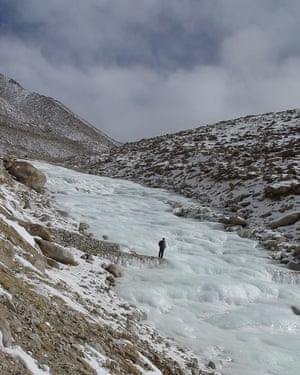
One reason for the rapid ice loss is that the Tibetan plateau, like the other two poles, is warming at a rate up to three times as fast as the global average, by 0.3C per decade. In the case of the third pole, this is because of its elevation, which means it absorbs energy from rising, warm, moisture-laden air. Even if average global temperatures stay below 1.5C, the region will experience more than 2C of warming; if emissions are not reduced, the rise will be 5C, according to a report released earlier this year by more than 200 scientists for the Kathmandu-based International Centre for Integrated Mountain Development (ICIMOD). Winter snowfall is already decreasing and there are, on average, four fewer cold nights and seven more warm nights per year than 40 years ago. Models also indicate a strengthening of the south-east monsoon, with heavy and unpredictable downpours. “This is the climate crisis you haven’t heard of,” said ICIMOD’s chief scientist, Philippus Wester.
There is another culprit besides our CO2 emissions in this warming story, and it’s all too evident on the dirty surface of the Mingyong glacier: black carbon, or soot. A 2013 study found that black carbon is responsible for 1.1 watts per square metre of the Earth’s surface of extra energy being stored in the atmosphere (CO2 is responsible for an estimated 1.56 watts per square metre). Black carbon has multiple climate effects, changing clouds and monsoon circulation as well as accelerating ice melt. Air pollution from the Indo-Gangetic Plains – one of the world’s most polluted regions – deposits this black dust on glaciers, darkening their surface and hastening melt. While soot landing on dark rock has little effect on its temperature, snow and glaciers are particularly vulnerable because they are so white and reflective. As glaciers melt, the surrounding rock crumbles in landslides, covering the ice with dark material that speeds melt in a runaway cycle. The Everest base camp, for instance, at 5,300 metres, is now rubble and debris as the Khumbu glacier has retreated to the icefall.
The immense upland of the third pole is one of the most ecologically diverse and vulnerable regions on Earth. People have only attempted to conquer these mountains in the last century, yet in that time humans have subdued the glaciers and changed the face of this wilderness with pollution and other activities. Researchers are now beginning to understand the scale of human effects on the region – some have experienced it directly: many of the 300 IPCC cryosphere report authors meeting in the Nepalese capital in July were forced to take shelter or divert to other airports because of a freak monsoon.
But aAside from such inconveniences, what do these changes mean for the 240 million people living in the mountains? Well, in many areas, it has been welcomed. Warmer, more pleasant winters have made life easier. The higher temperatures have boosted agriculture – people can grow a greater variety of crops and benefit from more than one harvest per year, and that improves livelihoods. This may be responsible for the so-called Karakoram anomaly, in which a few glaciers in the Pakistani Karakoram range are advancing in opposition to the general trend. Climatologists believe that the sudden and massive growth of irrigated agriculture in the local area, coupled with unusual topographical features, has produced an increase in snowfall on the glaciers which currently more than compensates for their melting.Advertisement
Elsewhere, any increase in precipitation is not enough to counter the rate of ice melt and places that are wholly reliant on meltwater for irrigation are feeling the effects soonest. “Springs have dried drastically in the past 10 years without meltwater and because infrastructure has cut off discharge,” says Aditi Mukherji, one of the authors of the IPCC report.
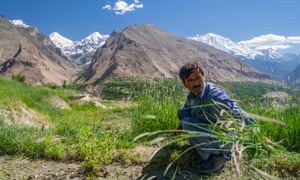
Known as high-altitude deserts, places such as Ladakh in north-eastern India and parts of Tibet have already lost many of their lower-altitude glaciers and with them their seasonal irrigation flows, which is affecting agriculture and electricity production from hydroelectric dams. In some places, communities are trying to geoengineer artificial glaciers that divert runoff from higher glaciers towards shaded, protected locations where it can freeze over winter to provide meltwater for irrigation in the spring.
Only a few of the major Asian rivers are heavily reliant on glacial runoff – the Yangtze and Yellow rivers are showing reduced water levels because of diminished meltwater and the Indus (40% glacier-fed) and Yarkand (60% glacier-fed) are particularly vulnerable. So although mountain communities are suffering from glacial disappearance, those downstream are currently less affected because rainfall makes a much larger contribution to rivers such as the Ganges and Mekong as they descend into populated basins. Upstream-downstream conflict over extractions, dam-building and diversions has so far largely been averted through water-sharing treaties between nations, but as the climate becomes less predictable and scarcity increases, the risk of unrest within – let alone between – nations grows.
Towards the end of this century, pre-monsoon water-flow levels in all these rivers will drastically reduce without glacier buffers, affecting agricultural output as well as hydropower generation, and these stresses will be compounded by an increase in the number and severity of devastating flash floods. “The impact on local water resources will be huge, especially in the Indus Valley. We expect to see migration out of dry, high-altitude areas first but populations across the region will be affected,” says Shea, also an author on the ICIMOD report.
As the third pole’s vast frozen reserves of fresh water make their way down to the oceans, they are contributing to sea-level rise that is already making life difficult in the heavily populated low-lying deltas and bays of Asia, from Bangladesh to Vietnam. What is more, they are releasing dangerous pollutants. Glaciers are time capsules, built snowflake by snowflake from the skies of the past and, as they melt, they deliver back into circulation the constituents of that archived air. Dangerous pesticides such as DDT (widely used for three decades before being banned in 1972) and perfluoroalkyl acids are now being washed downstream in meltwater and accumulating in sediments and in the food chain.
Ultimately the future of this vast region, its people, ice sheets and arteries depends – just as Khawa Karpo’s devotees believe – on us: on reducing our emissions of greenhouse gases and other pollutants. As Mukherji says, many of the glaciers that haven’t yet melted have effectively “disappeared because in the dense air pollution, you can no longer see them”.
The report firt published in The Guardian

